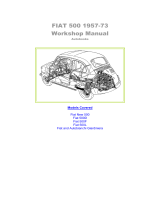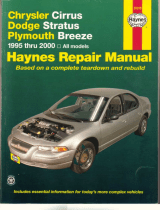Page is loading ...

1
WARNING: To ensure the drive is not unexpectedly started,
turn off and lock-out or tag power source before proceeding.
Failure to observe these precautions could result in bodily
injury.
PURPOSE
This procedure provides general direction and guidelines for the
installation, operation, and storage of conveyor pulley bushings.
TAPER-LOCK
1006 to 3030
3525 to 6050
7060 to 10085
120100
Insert Screws to Install Insert Screws to Remove
INSTALLATION
1. Determine bushing size from identication on face of
bushing.
2. Clean shaft, bore and outside of bushings, and bore of
hubs (taking bushings from hubs if already assembled).
Remove any oil, grease and dirt.
3. Slip shaft into pulley hubs and slip bushings onto shaft and
into hubs. Place screws loosely in holes that are threaded
on hub side (shown as on diagram above).
4. Locate shaft in desired position and tighten screws in each
bushing slightly to seat bushings in hubs.
5. Tighten screws alternately and evenly in one bushing only
until all screws are pulled up to the proper wrench torque
listed in Table 1. Do NOT over torque. Hammer against large
end of bushing. Hammer rst beside the screw farthest
from the bushing split and then hammer on the bushing
on the opposite side of the screw. Avoid hammering close
to the O.D. of the bushing to prevent damage. Working
toward the split, hammer on the bushing on each side of
each screw. Then hammer on each side of the bushing
split. Make sure that the surfaces on both sides of the split
are even. Screws can now be tightened a little more using
the specied torque. Repeat this alternating hammering
and retightening until the specied wrench torque no
longer turns the screws after hammering. Check to make
WARNING: Because of the possible danger to person(s) or
property from accidents which may result from the improper
use of products, it is important that correct procedures be
followed. Products must be used in accordance with the
engineering information specified in the catalog. Proper
installation, maintenance and operation procedures must be
observed. The instructions in the instruction manuals must
be followed. Inspections should be made as necessary to
assure safe operation under prevailing conditions. Proper
guards and other suitable safety devices or procedures as
may be desirable or as may be specified in safety codes
should be provided, and are neither provided by Baldor
Electric Company nor are the responsibility of Baldor Electric
Company. This unit and its associated equipment must be
installed, adjusted and maintained by qualified personnel
who are familiar with the construction and operation of all
equipment in the system and the potential hazards involved.
When risk to persons or property may be involved, a holding
device must be an integral part of the driven equipment
beyond the speed reducer output shaft.
sure the surfaces on both sides of the split are even. Fill
all other holes with grease to exclude dirt. If a key seated
bushing is used without a key, a uid resistant material to
prevent moisture can be lled in the key seat.
6. Tighten the second bushing per step 5.
REMOVAL
1. Remove all screws.
2. Insert screws into holes that are threaded on the bushing
side (shown as • on diagram). In sizes where washers are
found under the screw heads, be sure to use the washers.
NOTE: One screw in each hub is left over and is not
used in the removal process.
3. Tighten screws alternately until bushings are loosened in
hubs. If bushing does not loosen, tap on face of hub.
HE, QD
®
, AND XT
®
INSTALLATION
1. Determine bushing size from identication on face of
bushing.
2. Clean shaft, bore and outside of bearings, and bore of hubs
(taking bushings from hubs if already assembled). Remove
any oil, grease and dirt.
3. Slip shaft into pulley and slip bushings onto shaft and into
hubs. If required, carefully insert a wedge into bushing
split and tap lightly to allow bushing to slide on shaft. Align
unthreaded holes in bushing with threaded holes in hub.
Place bolts loosely in holes that are not threaded.
4. Locate shaft in desired position, remove wedges if used
and tighten bolts in each bushing slightly to seat bushings
in hubs.
5. Tighten bolts in a star pattern alternately and evenly as
illustrated in Figures 1 - 6 in one bushing only until all bolts
are pulled up to the proper wrench torque listed in Table
1. Do NOT over torque. If a key seated bushing is used
without a key, a uid resistant material to prevent moisture
can be lled in the key seat.
6. Check to ensure the bushing ange does not contact the
hub.
7. Tighten the second bushing per step 5.
1
1
1
1
1
2
2
2
2
2
2
3
3
3
3
3
3
4
4
4
4
4
5
5
5
6
67
8
Figure 1: QD-SF thru J
Figure 2: QD-M thru W
1
Figure 3: QD-S thru Z
Figure 4: HE-25 thru 40,
XT-15 through 80
Figure 5: HE-45 through 100,
XT-100
Figure 6: HE-120, XT
-120
Conveyor Pulley Bushing Instruction Manual
These instructions must be read thoroughly before installing or operating this product. This instruction manual was accurate at the time
of printing. Please see www.dodge-pt.com for updated instruction manuals.

P.O. Box 2400, Fort Smith, AR 72902-2400 U.S.A., Ph: (1) 479.646.4711, Fax (1) 479.648.5792, International Fax (1) 479.648.5895
Dodge Product Support
6040 Ponders Court, Greenville, SC 29615-4617 U.S.A., Ph: (1) 864.297.4800, Fax: (1) 864.281.2433
www.baldor.com
© Baldor Electric Company
MN4005 (Replaces 499657)
All Rights Reserved. Printed in USA.
12/14 Litho 10,000
REMOVAL
1. Remove all bolts.
2. Insert bolts into threaded holes on bushing ange.
3. Tighten bolts alternately until bushings are loosened in
hubs. If bushing does not loosen, carefully insert a wedge
into bushing split and tap lightly to allow bushing to slide
on shaft.
*QD is a registered trademark of Emerson Electric Co.
*XT is a registered trademark of Van Gorp Corporation
LONG-TERM PULLEY STORAGE INSTRUCTIONS
1. Block the pulley to keep the face from touching the ground.
2. Inside storage is recommended. If stored outside, protect
the pulley from harsh elements.
3. Clean the assembly before installation.
SHAFTING
1. A protective coating has been applied at the factory to
all exposed surfaces. For long term storage, additional
coatings of rust preventative are recommended.
2. Remove protective coatings before assembly of bearings
or other components.
LAGGED PULLEYS
1. Inside storage is recommended. Store in a cool, dark area
where the pulley will not be exposed to direct sunlight or
extreme temperature or humidity variations. Areas of high
ozone concentration, such as areas with electric motors
or other electrical arc producing machinery, should not be
used for storage.
2. Do NOT allow oil, grease, kerosene, solvents, or other
chemicals to contact the lagging.
3. After long-term storage, some oxidation may occur on
lagging surface. Reduce lagging thickness by 1/32” by
grinding to remove the oxidation.
PILLOW BLOCKS
1. Refer to manufacturer’s recommendations.
GENERAL OPERATION INSTRUCTIONS
1. For best practice, bushing bolts should be re-torqued
weekly for the rst month of operation.
2. No modications, repair, or other work should be performed
on the conveyor pulley assembly without prior written
consent of Baldor Electric Company.
3. Do NOT allow material to be trapped between the belt and
pulley face.
4. Do NOT allow material to build up on the pulley face.
5. Do NOT allow the edge of the conveyor belt to wander past
the edge of the rim.
6. Do NOT skew the pulley in an attempt to track the conveyor
belt.
Table 1 - Recommended Tightening Torque
Bushing Type
Screws
Torque
lb-ft
Hammer Size
(TL Only)
Qty Size
TL
1210,1215,1310,
1610 & 1615
2012
2517 & 2525
3020 & 3030
3535
4040
4545
5050
6060
7060 & 8065
10085
120100
2
2
2
2
3
3
3
3
3
4
4
6
3/8-16 NC
7/16-14 NC
1/2-13 NC
5/8-11 NC
1/2-13 NC
5/8-11 NC
3/4-10 NC
7/8-9 NC
1-1/4-7 NC
1-1/4-7 NC
1-1/2-6 NC
1-1/2-6 NC
15
23
36
67
83
142
204
258
650
650
1140
1140
6 LB.
6 LB.
6 LB.
6 LB.
12 LB.
12 LB.
12 LB.
12 LB.
20 LB.
20 LB.
20 LB.
20 LB.
HE
HE25
HE30
HE35
HE40
HE45
HE50
HE60
HE70
HE80
HE100
HE120
4
4
4
4
6
6
6
6
6
6
8
3/8-16 NC
1/2-13 NC
9/16-12 NC
5/8-11 NC
5/8-11 NC
3/4-10 NC
7/8-9 NC
1-8 NC
1-1/8-7 NC
1-1/4-7 NC
1-1/4-7 NC
30
60
90
140
140
200
350
500
500
600
600
N/A
QD
SF
E
F
JS or J
MS or M
NS or N
PS or P
WS or W
SS or S
ZS or Z
3
3
3
3
4
4
4
4
5
5
3/8-16 NC
1/2-13 NC
9/16-12 NC
5/8-11 NC
3/4-10 NC
7/8-9 NC
1-8 NC
1-1/8-7 NC
1-1/4-7 NC
1-1/8-7 NC
30
60
75
135
225
300
450
600
750
600
N/A
XT
XTB15
XTB20
XTB25
XTB30
XTB35
XTB40
XTB45
XTB50
XTB60
XTB70
XTB80
XTB100
XTB120
4
4
4
4
4
4
4
4
4
4
4
6
8
1/4-20 NC
5/16-18 NC
3/8-16 NC
7/16-14 NC
1/2-13 NC
9/16-12 NC
5/8-11 NC
3/4-10 NC
7/8-9 NC
1-8 NC
1-1/8-7 NC
1-1/8-7 NC
1-1/8-7 NC
7.9
16.7
29.2
45.8
70
100
140
250
400
600
750
750
750
N/A
* Torque values listed are based on dry torque.
Dodge product installation manuals
These can be found on the Dodge website using the following
address: http://www.baldor.com/support/product_manuals.asp
*4005-1214*
/


